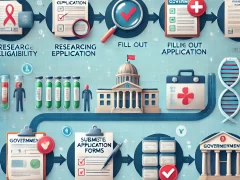
Exploring Government Funding Options for Cord Blood Banking
Uncovering Government Support for Cord Blood Banking
Cord blood banking has become an increasingly important aspect of healthcare, providing a valuable source of stem cells for various medical treatments. As the demand for cord blood banking services grows, individuals and organizations are seeking ways to access financial support from the government to offset the costs associated with this essential service. In this article, we’ll explore the various government funding options available for cord blood banking and how you can leverage these resources to make this vital healthcare service more accessible.
Cord blood banking can be a significant financial investment, and many families may find it challenging to afford the associated costs. Fortunately, governments around the world have recognized the importance of cord blood banking and have implemented various funding programs to support individuals and organizations in this field.
One of the primary sources of government funding for cord blood banking is through public cord blood banks. These banks are often funded by government agencies or initiatives, providing free or subsidized cord blood collection and storage services for eligible individuals. By leveraging these public cord blood bank programs, families can access cord blood banking services without the burden of the full cost.
Exploring State-Level Funding Initiatives
In addition to federal-level funding, many states have also developed their own programs to support cord blood banking. These state-level initiatives may offer financial assistance, tax credits, or other incentives to encourage the use of cord blood banking services. For example, some states provide reimbursements or subsidies for cord blood collection and storage, making it more affordable for families to participate.
It’s important to research the specific funding options available in your state, as the eligibility criteria and program details can vary. By staying informed about these state-level initiatives, you can identify the best opportunities to access government support for your cord blood banking needs.
Leveraging Public-Private Partnerships
Another avenue for government funding in the cord blood banking sector is through public-private partnerships. These collaborations between government agencies and private organizations can provide a range of funding and support options, including grants, research funding, and public awareness campaigns.
By engaging with these public-private initiatives, cord blood banking providers and families can access additional resources and expertise to enhance their services and make them more accessible. These partnerships can also help drive innovation and improve the overall quality and efficiency of cord blood banking in your community.
To take advantage of government funding opportunities for cord blood banking, it’s essential to understand the application process and eligibility requirements. This may involve submitting formal proposals, completing detailed application forms, or providing specific documentation to demonstrate your need for financial support.
It’s recommended to carefully review the guidelines and instructions provided by the relevant government agencies or programs, and to seek assistance from experienced professionals or advisors who can guide you through the application process. By following the proper procedures and submitting a comprehensive application, you can increase your chances of securing the necessary funding to support your cord blood banking initiatives.
Cord blood banking is a vital healthcare service that provides a valuable source of stem cells for various medical treatments. As the demand for this service continues to grow, individuals and organizations are seeking ways to access government funding to offset the associated costs. By exploring the various funding options available at the federal, state, and local levels, as well as leveraging public-private partnerships, you can unlock the support needed to make cord blood banking more accessible and affordable for your community.
The Role of Regulatory Agencies in Cord Blood Banking
The cord blood banking industry is a complex and highly regulated field, with various government agencies playing a crucial role in overseeing its operations. These regulatory bodies are responsible for ensuring the safety, efficacy, and ethical standards of cord blood collection, storage, and distribution.
The Role of the FDA in Cord Blood Regulation
The United States Food and Drug Administration (FDA) is the primary regulatory authority that oversees the cord blood banking industry. The FDA classifies cord blood as a “biological product,” which means it is subject to stringent regulations and guidelines. The FDA’s jurisdiction covers the entire lifecycle of cord blood, from collection to processing, storage, and eventual therapeutic use.
One of the FDA’s key responsibilities is to ensure the safety and purity of cord blood units. They accomplish this through the implementation of Good Tissue Practices (GTP), which establish standards for handling, processing, and storing cord blood. Cord blood banks must adhere to these GTP regulations to maintain their FDA licensing and continue operating.
Additionally, the FDA plays a crucial role in approving the use of cord blood for specific medical therapies. Before a cord blood unit can be used for treatment, the FDA must evaluate the safety and efficacy of the product, ensuring that it meets the necessary clinical and scientific requirements.
The Oversight of State Regulatory Agencies
While the FDA provides the overarching regulatory framework for the cord blood banking industry, individual states also have their own regulatory agencies that contribute to the oversight of this sector. These state-level agencies often work in conjunction with the FDA to ensure compliance with both federal and state-specific regulations.
For instance, many states require cord blood banks to obtain licenses or permits to operate within their jurisdictions. These state-level regulations may cover aspects such as facility inspections, quality control measures, and record-keeping requirements. By enforcing these state-specific regulations, regulatory agencies help to maintain the integrity and safety of the cord blood banking ecosystem.
Moreover, state agencies may also be responsible for managing and overseeing public cord blood banks or registries within their borders. These public banks play a crucial role in increasing the diversity of the national cord blood inventory, which is essential for improving patient access to suitable cord blood units for transplantation.
The Importance of Compliance and Collaboration
Navigating the complex regulatory landscape of cord blood banking requires cord blood banks to maintain strict compliance with the various federal and state-level regulations. Failure to adhere to these regulations can result in significant penalties, including fines, revocation of licenses, or even criminal charges in extreme cases.
To ensure full compliance, cord blood banks often work closely with regulatory agencies, engaging in ongoing communication and collaborating on the development of new policies and guidelines. This collaborative approach helps to foster a culture of transparency and accountability within the industry, ultimately benefiting patients and the public.
Moreover, the regulatory oversight provided by government agencies plays a crucial role in maintaining public trust in the cord blood banking industry. By upholding rigorous standards and guidelines, these agencies help to assure the safety, quality, and ethical practices of cord blood collection, storage, and distribution.
The regulatory agencies responsible for overseeing the cord blood banking industry play a pivotal role in ensuring the safety, efficacy, and ethical standards of this burgeoning field. Through their enforcement of federal and state-level regulations, as well as their collaborative approach with industry stakeholders, these agencies help to safeguard the interests of patients and the public, while also fostering the continued growth and development of the cord blood banking industry.
Analyzing the Cost-Benefit of Cord Blood Banking
Exploring the Financial Implications of Cord Blood Banking
Cord blood banking has become an increasingly popular option for expectant parents, offering the potential to preserve valuable stem cells for future medical use. However, the decision to bank cord blood is often accompanied by concerns about the financial implications. In this article, we will delve into the cost-benefit analysis of cord blood banking, exploring the various factors that can impact the financial viability of this decision.
Understanding the Costs of Cord Blood Banking
The cost of cord blood banking can vary significantly depending on the service provider, geographic location, and the specific package selected. Typically, the initial enrollment fee can range from $1,000 to $3,000, with an annual storage fee ranging from $100 to $300 per year. Some providers may also offer discounts or payment plans to make the process more accessible.
It’s important to note that the cost of cord blood banking can be influenced by additional factors, such as the type of collection kit required, the need for additional testing, or the potential for additional services like sibling banking or delayed cord clamping.
Evaluating the Potential Benefits
The potential benefits of cord blood banking can be both medical and financial. From a medical perspective, stored cord blood can be used for stem cell transplants, regenerative therapies, and the treatment of various diseases, such as leukemia, lymphoma, and certain genetic disorders. In some cases, the availability of a personal cord blood sample can increase the chances of a successful treatment.
Additionally, the financial benefits of cord blood banking can be significant. If the stored cord blood is ever needed for medical treatment, the cost of obtaining the sample from a public bank can be avoided, potentially saving thousands of dollars. This can be especially valuable for families with a history of conditions that may require stem cell therapies.
Considering the Likelihood of Usage
One of the key factors in the cost-benefit analysis of cord blood banking is the likelihood of the stored sample being used. According to industry estimates, the probability of a child needing their own cord blood for a stem cell transplant is approximately 1 in 2,000 to 1 in 20,000. However, the likelihood of the cord blood being used for a family member can be significantly higher, ranging from 1 in 400 to 1 in 3,000.
It’s essential to carefully weigh the potential benefits against the long-term financial commitment required for cord blood banking. Families should consider their medical history, the prevalence of conditions that may require stem cell therapies, and their overall financial situation when making this decision.
Exploring Government Funding Options
Recognizing the potential value of cord blood banking, some governments and healthcare systems have implemented funding programs to support families in accessing this service. These programs can help offset the initial enrollment and storage fees, making cord blood banking more accessible.
In the United States, for example, the Stem Cell Therapeutic and Research Act of 2005 established the C.W. Bill Young Cell Transplantation Program, which provides funding for the collection and storage of cord blood units. Families may be eligible for financial assistance or subsidized cord blood banking through this program, depending on their specific circumstances.
Similarly, in the United Kingdom, the National Health Service (NHS) offers a free cord blood banking service through the NHS Cord Blood Bank. This service is available to all expectant parents in the UK, providing a cost-effective option for those who wish to preserve their child’s cord blood.
Cord blood banking is a complex decision that requires careful consideration of the financial implications. By understanding the costs involved, evaluating the potential benefits, and exploring available government funding options, families can make an informed decision that aligns with their medical needs and financial capabilities. As the field of regenerative medicine continues to evolve, the value of cord blood banking may become increasingly significant, underscoring the importance of understanding the cost-benefit analysis in this important healthcare decision.
Ethical Considerations in Accessing Cord Blood Banking Subsidies
As parents, the decision to bank your child’s cord blood is a significant one, with far-reaching implications. While the potential medical benefits of cord blood stem cells are well-documented, the financial burden of cord blood banking can be a significant barrier for many families. Fortunately, various government funding options are available to help offset the costs and make this important healthcare choice more accessible.
Uncovering Cord Blood Banking Subsidies
Governments worldwide recognize the value of cord blood banking and have implemented programs to subsidize the costs for families. In the United States, for example, the Health Resources and Services Administration (HRSA) offers the Maternal and Child Health Services Block Grant, which can be used to cover the expenses of cord blood banking for eligible families. Similarly, countries like Canada and the United Kingdom have national cord blood banking programs that provide financial assistance to parents.
Exploring State-Level Funding Opportunities
In addition to federal initiatives, many state governments in the U.S. have also developed their own cord blood banking subsidy programs. These state-level programs often target low-income families or those with specific medical needs, ensuring that the benefits of cord blood banking are accessible to a wider population. Parents should research the available options in their state, as eligibility requirements and funding levels can vary significantly.
Accessing government funding for cord blood banking typically involves navigating a complex application process. Parents will need to gather relevant documentation, such as proof of income, medical records, and residency information. It’s essential to carefully review the program guidelines and deadlines to ensure a successful application. Many government agencies also offer assistance and guidance to help families through this process.
Considering Private Cord Blood Bank Partnerships
Some private cord blood banks have also established partnerships with government agencies or non-profit organizations to provide subsidized services. These collaborations can make cord blood banking more affordable for families who may not qualify for direct government funding. Parents should research their options and ask their chosen cord blood bank about any available assistance programs.
Advocacy and Public Awareness
To ensure that government funding for cord blood banking remains a priority, it’s crucial for parents and healthcare providers to advocate for increased awareness and funding. By engaging with policymakers, participating in public education campaigns, and sharing their personal experiences, individuals can help shape the future of cord blood banking accessibility.
Accessing government funding for cord blood banking can be a complex process, but the potential benefits make it a worthwhile pursuit. By understanding the available options, navigating the application process, and advocating for increased support, families can take advantage of these valuable resources and ensure that the gift of cord blood is available to all.
Exploring Government Funding Options for Cord Blood Banking
Navigating the complex landscape of government funding for cord blood banking can be a daunting task, but it’s an essential step for organizations looking to establish or expand their programs. In this article, we’ll delve into the various grant opportunities available and provide a roadmap for successfully applying for this critical financial support.
Identifying Relevant Government Grant Programs
The first step in securing government funding for your cord blood banking initiative is to identify the appropriate grant programs. Start by researching federal agencies, such as the National Institutes of Health (NIH) and the Health Resources and Services Administration (HRSA), which often have dedicated funding streams for biotechnology and healthcare innovation projects. Additionally, explore state-level grant opportunities, as many local governments offer financial assistance for initiatives that align with their public health priorities.
Understanding the Application Process
Once you’ve identified the relevant grant programs, it’s time to dive into the application process. Each funding source will have its own set of requirements, deadlines, and submission guidelines, so it’s crucial to review them thoroughly. Pay close attention to the eligibility criteria, as some grants may be limited to specific types of organizations or projects.
Crafting a Compelling Proposal
The key to securing government funding lies in your ability to craft a compelling grant proposal. Begin by clearly articulating the need for your cord blood banking program, highlighting its potential impact on the community and the broader healthcare landscape. Demonstrate your organization’s expertise, resources, and track record of success in related initiatives. Outline a detailed project plan, including specific goals, milestones, and a well-thought-out budget that aligns with the grant’s requirements.
Leveraging Partnerships and Collaborations
Strengthening your grant application through strategic partnerships and collaborations can significantly improve your chances of success. Consider reaching out to other healthcare providers, research institutions, or community organizations that share your mission and could contribute valuable expertise or resources to the project. Collaborative proposals often carry more weight with funding agencies, as they showcase the broad impact and cross-sector support for your initiative.
Once you’ve submitted your grant application, be prepared for a thorough review process. Funding agencies often receive a high volume of proposals, so it’s essential to stay patient and responsive during this time. Be prepared to address any questions or clarifications requested by the review panel, and be willing to revise your proposal if necessary.
Maintaining Compliance and Reporting Requirements
If your grant application is successful, the work doesn’t end there. Ensure that you fully understand and comply with the reporting and compliance requirements set forth by the funding agency. This may include submitting regular progress reports, financial statements, and other documentation to demonstrate the effective use of the grant funds. Staying on top of these ongoing obligations is crucial to maintain your funding and establish a strong track record for future grant opportunities.
By navigating the complex world of government funding for cord blood banking, you can unlock the resources needed to establish or expand your program, ultimately contributing to the advancement of this critical healthcare service. With a strategic approach, persistence, and a commitment to compliance, your organization can secure the financial support it needs to make a lasting impact on the communities you serve.
Conclusion
As the article has explored, the landscape of government funding options for cord blood banking is complex and multi-faceted. From the role of regulatory agencies in oversight to the intricate cost-benefit analysis, there are numerous factors to consider when navigating this field.
One of the key takeaways is the importance of understanding the ethical considerations involved. Accessing cord blood banking subsidies raises important questions about equitable access, privacy, and the potential for misuse. Policymakers must strike a delicate balance between promoting the life-saving benefits of cord blood banking and safeguarding the rights and well-being of the donors and their families.
The application process for cord blood banking grants can also be daunting, requiring meticulous attention to detail and a thorough understanding of the eligibility criteria. Prospective applicants must be prepared to navigate a labyrinth of bureaucratic hurdles, armed with a strong understanding of the specific requirements and nuances of each funding program.
Despite these challenges, the potential benefits of government support for cord blood banking are significant. Increased funding can help to expand access to this critical resource, ensuring that more families have the opportunity to preserve their newborn’s umbilical cord blood for potential future medical use. Moreover, robust government investment in cord blood banking can drive innovation, fuel research, and ultimately improve patient outcomes.
As policymakers and healthcare providers continue to grapple with the complexities of cord blood banking, it is essential that they adopt a holistic, collaborative approach. By bringing together diverse stakeholders – from regulatory agencies and healthcare providers to patient advocacy groups and cord blood banking experts – a comprehensive, evidence-based framework can be developed to guide the allocation of government resources and ensure the equitable and ethical provision of these services.
In the end, the success of government funding for cord blood banking will hinge on the ability of policymakers to navigate the intricate web of regulatory, financial, and ethical considerations. By striking the right balance and fostering a supportive ecosystem, they can unlock the transformative potential of cord blood banking and deliver lasting benefits to individuals, families, and communities across the country.



















